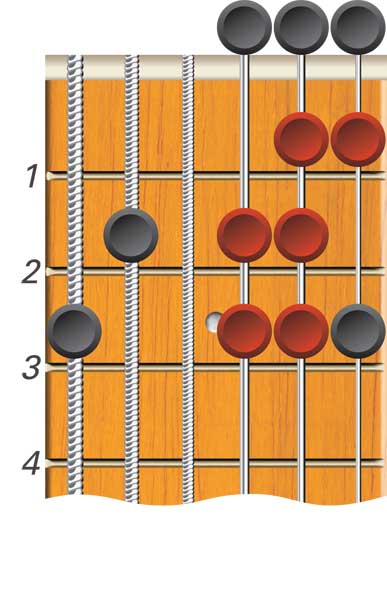
Chord Based Licks
This lesson introduces Blues licks that are based solely around a chord shape. A chord based lick is when the left hand frets a chord shape and maintains that chord shape for the duration of the chord. Licks are created by altering the chord shape with the addition of other notes based around the chord. The most common notes that can be added to a chord shape are notes taken from the respective Major and Blues scales.
Basic E Chord Licks
E chord licks use notes taken directly from the E major scale and the E Blues scale. The diagram highlights the extra notes that can be added to a basic E chord to create an E chord lick.


The following lick is based around the basic E chord. Note: the symbol N.C. means that no chord is fretted with the left hand.

Basic A Chord Licks
A chord licks use notes taken directly from the A major scale and the A Blues scale. The diagram highlights the extra notes that can be added to a basic A chord to create an A chord lick.


The following lick involves barring the basic A chord with the 1st finger of the left hand.


Basic C Chord Licks
C chord licks use notes taken directly from the C major scale and the C Blues scale. The diagram highlights the extra notes that can be added to a basic C chord to create a C chord lick.



Basic G Chord Licks
G chord licks use notes taken directly from the G major scale and the G Blues scale. The diagram highlights the extra notes that can be added to a basic G chord to create a G chord lick.




Basic D Chord Licks
D chord licks use notes taken directly from the D major scale and the D Blues scale. The diagram highlights the extra notes that can be added to a basic D chord to create a D chord lick.


Dropped D Tuning

Although it is possible to create D chord licks using standard tuning and a basic D chord, it is common practice to lower the 6th string (E) one tone to the note D. This is called dropped D tuning.
Assuming your guitar is in tune, detune the 6th string so the note on the 7th fret of the sixth string is the same as the open 5th string.
The following example is a 12 Bar Blues progression in the key of D. Note: The basic G chord is altered because the 6th string is now tuned one tone lower. The root bass note of the G chord is now located one tone higher, on the 5th fret.




F Chord Licks – Root Six Major Bar Chord

F chord licks are based upon the alternative fingering for the root six major bar chord (see adjacent diagram). This fingering frees the 4th finger of the left hand, allowing this finger to fret the other notes based around the chord to create licks.
The root note of this chord shape is located on the 6th string which determines the name of the chord depending on which fret the chord shape is fretted. This chord shape is used for the A (5th fret) and the B chord (7th fret) in the following 12 Bar Blues progression.




Root Five Major Bar Chord

B chord licks are based upon the alternative fingering of the root five major bar chord. The adjacent diagram illustrates this chord and highlights the additional notes based around the chord that may be used to create licks. The root note of this chord shape is located on the 5th string which determines the name of the chord depending on which fret the chord shape is fretted. This chord shape is used for the B chord (2nd fret) in the following 12 Bar Blues progression.



